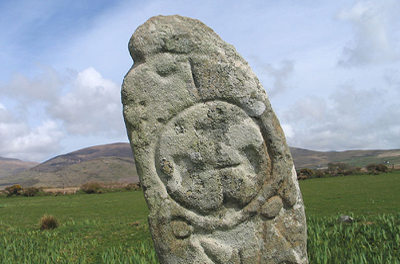✝️ Key Types of Celtic Christian Stone Slab Crosses in Ireland
Ireland’s early Christian period gave rise to a remarkable legacy of stone crosses — carved monoliths that stand as both devotional art and cultural symbols. These crosses date from as early as the 7th century and vary in form, function, and detail. Here are the key types you’ll encounter:
🪨 Early Slab Crosses (7th–8th Century)
These are simple upright stone slabs with inscribed or relief-carved crosses. Often used as grave markers or devotional waypoints, they represent the earliest form of Christian stone crosses in Ireland.
Example: Reask Monastic Site, Co. Kerry – a 7th-century site with multiple inscribed slabs bearing early Christian motifs and Latin crosses.
⭕ Ringed Celtic Crosses (8th–9th Century)
Characterized by the distinctive ring encircling the arms of the cross, these represent the classic “Celtic Cross” and often feature interlace patterns, spiral motifs, and biblical scenes.
Example: Muiredach’s High Cross, Monasterboice, Co. Louth – one of Ireland’s finest high crosses, richly carved with biblical scenes and considered a masterpiece of early medieval sculpture.
🏛️ High Crosses of the Monastic Golden Age (9th–10th Century)
Towering, elaborately decorated, and often narrative in style, these crosses were erected at major monastic sites. They served both as teaching tools and status symbols of ecclesiastical power.
Example: Clonmacnoise Cross of the Scriptures, Co. Offaly – an iconic 4-metre-high cross at the heart of one of Ireland’s most revered monastic settlements, depicting both Old and New Testament scenes.
🧱 Plain or Wheel Crosses (10th–12th Century)
These crosses are more stylized and geometric, often with minimal decoration. Many are smaller or broken fragments from a once-flourishing tradition.
Example: Kilfenora High Crosses, Co. Clare – several well-preserved examples of plainer high crosses can be found in Kilfenora Cathedral, known as “The City of the Crosses.”
🏞️ Remote Pilgrimage Crosses
Often placed at boundaries of monastic land or along pilgrimage routes, these crosses served as spiritual signposts. They are typically simple and weather-worn, but often in stunning landscapes.
Example: Glencolmcille Turas Stations, Co. Donegal – a pilgrimage trail marked by carved cross slabs and inscribed stones, used by early Christian devotees and still followed today.
Let me know if you’d like:
- A visual reference sheet with images and map coordinates
- A printable PDF or WordPress-friendly version
- Or an extended version including cross dimensions, iconography, and associated saints

